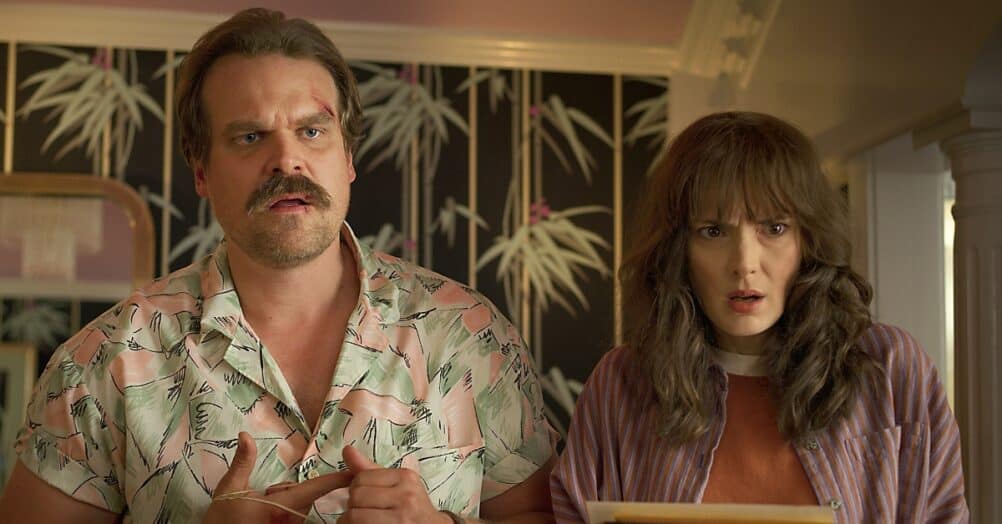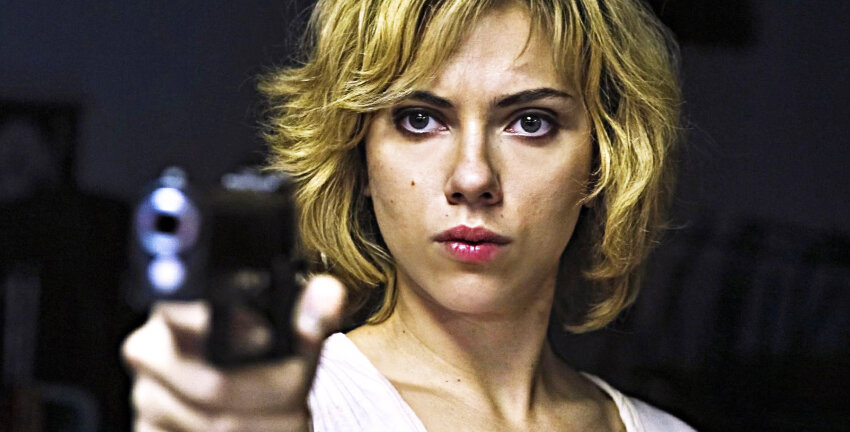
Hey folks, just wanted to pop in before this week’s reviews and say thanks for keeping up with our little 4-color corner of JoBlo.com, and for putting up with our ongoing struggle with Canadian spelling. Also the lack of boobs.
As you may have noticed last week, we’ve made some changes to the column, chief among them being a move to Thursday–which makes a lot more sense, given that Wednesday is Comics Day–and the addition of our Talking Points down at the bottom of the column. In case you haven’t noticed, we like to talk about comics, and we’d love to have you guys join in on the conversation, too. So post in the comments below, or in our thread over on the forums, and let us know what you think. Because frankly, there isn’t enough arguing on the internet, especially not about comics.
IF YOU WANT BLOOD, YOU GOT IT!
Punisher MAX: Happy Ending One-Shot (Marvel, $4.99)
By Jeb D.
Given the sanguinary mayhem that Juan Jose Ryp has wrought in Warren Ellis comics like Black Summer and No Hero, hooking him up with the MAX version of The Punisher was not just inevitable, but frankly necessary. And he doesn’t disappoint here. Granted, there are fewer random body parts or rivers of gore than Ellis gleefully calls for, but Peter Milligan’s script (about yet another poor schlub getting caught in the crossfire of Frank Castle’s war on crime) provides plenty of opportunity for flying lead, and slugs taking big chunks out of wiseguys. Goran Parlov may still be the “reference” artist for the 21st century version of Frank Castle, but future stories with more of this sort of action from Ryp would be welcome.
The setup is pretty simple: an unhappily married accountant ventures into a massage parlor in a sleazy part of town, not entirely sure just what he should want, or expect, out of this daring visit, when (naturally) mob violence breaks out, and he and the girl he was “doing business” with have to hightail it out, spending the rest of the issue on the run from angry mobsters, and caught in the crossfire of their showdown with The Punisher.
In the wake of Garth Ennis’ departure from the book, Marvel seems to have split the MAX version of The Punisher in two: there’s the ongoing series currently being guided to new heights of horror by Jason Aaron, and these one-shot adventures where (as is the case here) Frank is often not even the principal character, but rather a ruthless force of nature that is nearly as dangerous to the innocent as to the guilty. Many recent Punisher books have been written by guys with crime novelist backgrounds, like Duane Swierczynski, but comics vet Milligan shows here that he can be just as generous with the mayhem and twist endings.




 BRUBAKER SHOWS HOW IT’S DONE
BRUBAKER SHOWS HOW IT’S DONE
Secret Avengers #4 (Marvel, $3.99)
By Jeb D.
If Ed Brubaker did nothing but sit around dreaming up tales of humanity’s dark side for Criminal, he’d be one of today’s most important comic writers. What makes him remarkable is how deftly he can move from such pulpy noir to things like the espionage-based mysteries of Captain America, the soul-searching of Daredevil… or the flat-out fun adventure of Secret Avengers. In this issue, he and artist Mike Deodato bring a breathless wrapup to their initial four-issue story arc, and look like they’re just starting to hit their stride.
Really, this book has everything that a good adventure comic–hell, a good adventure story of any kind–should have: cliffhangers and double-crosses, heroes found in unlikely places, dialog that mixes crafty exposition with snappy humor, and planet-shaking action. Steve Rogers and his new Secret Avengers are on Mars (and Brubaker makes it feel even more natural than their being in, say, Seattle), confronting an interstellar menace tied to the space-borne superhero Nova. And when Richard Rider is possessed by our old friend the Serpent Crown, it’s time for Steve Rogers to step up once more, and don the Kree helmet whose power will allow him to confront the possessed Rider… if it doesn’t kill him first.
It’s good straightforward stuff, with Brubaker cutting back and forth among the various characters, the interplay between Sharon Carter and Eric “Ant-Man” O’Grady being the issue’s humorous high point. Mike Deodato is a polarizing artist, but if you like his brooding, elegant women and teeth-clenched he-men, you’ll have a blast with the climactic fight between the two bearers of Nova’s power. And kudos to Brubaker for neatly tying this in with the current Thanos series.
Brubaker and Deodato are just getting warmed up on the series. They’ve sown seeds of intrigue and danger that are going to begin to pay off next issue; more to the point, Brubaker continues to defy all convention as he has made this latest “Steve Rogers is no longer Captain America” storyline maybe the first such that feels motivated by the demands of storytelling more than of the marketplace.




 THE LOSERS: FAITHFUL COMIC TO FILM
THE LOSERS: FAITHFUL COMIC TO FILM
The Losers Book 1 & 2 (Vertigo, $19.99/$24.99)
by Graig Kent
I’m one of those guys who, if I wasn’t already, becomes interested in a comic-to-film property as the release date of the film approaches. Before the film is released, I feel a need to be able to say (not to anyone in particular, mind) that I’m familiar with the source. Happened with Ghost World and American Splendor and 300, and I’m sure it’ll happen with Cowboys and Aliens and Black Hole too. Most recently, it happened with the Losers, an acclaimed Vertigo series which I all but ignored until this past January when the “Volume 1 & 2” (or “Book 1”) trade paperback came out. I was surprised. The Losers isn’t typical Vertigo fare. It’s not the fantasy of Sandman or Fables or Preacher, it’s a plate-of-ribs action book with a dish of cole-slaw espionage and baked-beans social commentary on the side. It’s a breezy read, which isn’t to say it’s lightweight, but Andy Diggle is a fluid writer and Jock’s illustrations provide plenty of momentum. It’s the between-arc, character-based stuff, like “Downtime” (with art by Shawn Martinbrough) which interfere with this pace, though I hesitate to call it unnecessary. The first arc, “Goliath”, is the framework for the film, which actually played pretty true, with some obvious Hollywood tweaks, like making Aisha and Clay an item, introducing Max into the fray earlier, and upping the ante on Max’s scheming. Of course, I had only read 1/3 of the series, and was surprised to find in the recently released book 2 (loaded with a whopping 20 issues) that Aisha and Clay indeed became an item (sorta), and that Max’s plan, while different, was no less Lex Luthor-ian in its ludicrousness. The film was a bit smarmier and sexier than the comic, but by and large they equate pretty well with one another. The tail end of Book 2 loses some of its refinement, with a plodding 4-page exposition on Max’s history in the penultimate issue, and some less than grand departures by some of the cast. Overall, the series is a wild, entertaining ride, but, as goes for the film as well, nothing groundbreaking.





 ‘DANGER’ DIABOLICALLY DUMB FUN
‘DANGER’ DIABOLICALLY DUMB FUN
Danger Girl: The Ultimate Collection HC (IDW Publishing, $50)
By Devon Sanders
Released at the end of the 1990’s speculator boom, Danger Girl was a bit of a risk. Written by a virtual unknown, Andy Hartnell, it had two things going for it. One: the stunning art and design work of former Gen 13 artist J. Scott Campbell and two: an audience raised on a steady diet of sex, intrigue, guns and Jim Lee. Ultimately, it was well worth the risk, Running a spare but action-packed seven issues, DG spawned a video game, a toy line, huge comics sales and was chosen by then publisher DC Comics as one of the series important enough to launch the hardcover “Absolute” format. Now, nine years after it ceased publication, IDW collects it all into one beautifully done hardcover. Danger Girl is the story of Abbey Chase, Sydney Savage and Natalia Kasstle, three impossibly beautiful spies recruited by an ultra-secret organization to locate and retrieve several mystic artifacts and keep them from the clutches of the insidious and all-powerful Hammer Syndicate. The Ultimate Collection finds Campbell in his artistic prime; combining women with impossible curves and layouts that nearly ten years on remain as vibrant as ever. The story itself is ridiculously derivative, swiping and mashing-up everything from G.I. Joe to Raiders of The Lost Ark to Charlie’s Angels, but you know what? With every turn of the page, you can tell Campbell and Co. were having a hell of a good time paying simple homage to the things they love: women, guns, 80’s cartoons, Bruckheimer and Bond. High art and common sense be damned, I loved it! Danger Girl: The Ultimate Collection will help you rediscover what it is to kick back and simply enjoy comics again.





 GRAIG LACKS RESPECT FOR ‘AUTHORITY’
GRAIG LACKS RESPECT FOR ‘AUTHORITY’
The Authority: The Lost Year #1 – 12 (Wildstorm, $2.99ea)
by Graig Kent
It began almost 4 years ago with Grant Morrison, intended as a relaunch of the Authority and (alongside his WildCATS non-start) a revitalization of the Wildstorm universe. Alas, Morrison and Gene Ha got two issues out, two fresh, wild and wholly unique issues, before they threw in the towel (due to schedules and apathy). Two years later, Keith Giffen took up the reigns of an Authority lost in alternate dimensions, finishing off Morrison’s first story arc and moving forward from there. The first arc found the Authority on, ostensibly, “our earth”, and while Giffen and artists Darick Robertson and Trevor Scott do a decent job of telling the story, their styles of storytelling sadly clash loudly with Morrison and Ha’s set-up. The second arc (with layouts by Brian Stelfreeze and art by Joel Gomez) finds the Authority in a Groundhog Day world where the last day of 1999 keeps repeating itself, a situation caused by the Authority that rules this world devoid of any other heroes. The third storyline find Giffen joined by his frequent writing partner J.M. Dematteis (and artists David Williams and JJ Kirby). With Giffen and DeMatteis teaming up you can bet it’s a “Bwa Ha Ha”-style story featuring the Authority, and yes, it’s just as ill-fitting as you could imagine (even as a devoted fan of the Giffen/DeMatteis style, I found it supremely awkward). The final arc with artist Brandon Badeaux quite literally made the series, though, as the Authority faces off with yet another world-conquering interpretation of themselves, but one that’s oppressed all the other superhumans and is Big Brother-ing the hell out of that world and the conflict is as epic as it should be. The final issue (art by Jerry Ordway and Kevin Nowlan), which acts as epilogue, delves into the effect all these encounters with their other selves has had on the team, which is to say, it’s delivered as profound but likely not very lasting. I’m not a regular reader of the Authority, having previously read the seminal Warren Ellis and less-seminal Mark Millar issues. Giffen holds a light up to that “classic” (if you can call them that) interpretation of the team and reveals some interesting thoughts about what the purpose of the characters are, and what they could become, but the care in which Giffen deals with them shows some true affection for the team rather than just jamming out another workhorse project. As a series, The Lost Year is generally very interesting and entertaining, if wildly uneven.



 ‘BALTIMORE’ A MONSTER-HUNTING GOOD TIME
‘BALTIMORE’ A MONSTER-HUNTING GOOD TIME
Baltimore: The Plague Ships #1 (of 5)(Dark Horse Comics)
By Sean Fahey
At the risk of sounding cliché, Baltimore is one of those stories that immediately grabs you by the throat and simply refuses to let go. From the first panel, we’re thrown right in the middle of the action, with the story’s protagonist, soldier turned monster hunter Lord Henry Baltimore, chasing after, and doing battle with, a dozen vampire German soldiers through the dark gothic streets of post-World War I Europe. This is how you open a comic book. Ensure your reader’s attention and start piling on the mysteries. Who is Lord Baltimore? Why is he chasing vampires? Where did these vampires come from, and what is their connection to the mysterious plague that has devastated Europe? Oh, and ah….why does Lord Baltimore only have one leg? Not a lot of answers in this inaugural issue, but, to be honest, that would take all the fun out of it.
Baltimore is classic Mike Mignola. As with his previous creations, Mignola (along with series co-writer Christopher Golden) creates a rich and atmospheric backdrop for this gothic horror tale; you get a real sense of history and locale (almost as if you’re looking through a window into old Europe), and that helps breathe life into the characters and their actions. In addition, Mignola treats the monsters like “monsters.” No romantic, aristocratic, “eternal embrace” misconceptions here. These vampires are evil, hideous mothers that need to be put down. It’s quite refreshing to see in the “Twilight” era, and more importantly makes for a good horror story. Recommended.





This week’s Talking Points:
What genre would you like to see more represented in comics? Horror? Westerns? War?
What’s the better Losers, comic or film?
If Morrison had continued with the Authority and WildCATS in 2007, do you think the Wildstorm Universe would be in better or worse shape than it is today?
















Follow the JOBLO MOVIE NETWORK
Follow us on YOUTUBE
Follow ARROW IN THE HEAD
Follow AITH on YOUTUBE